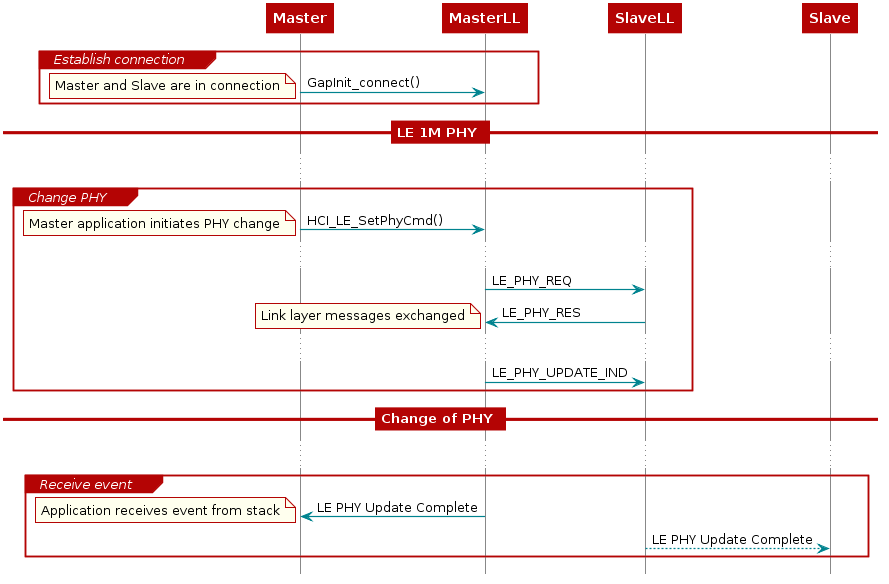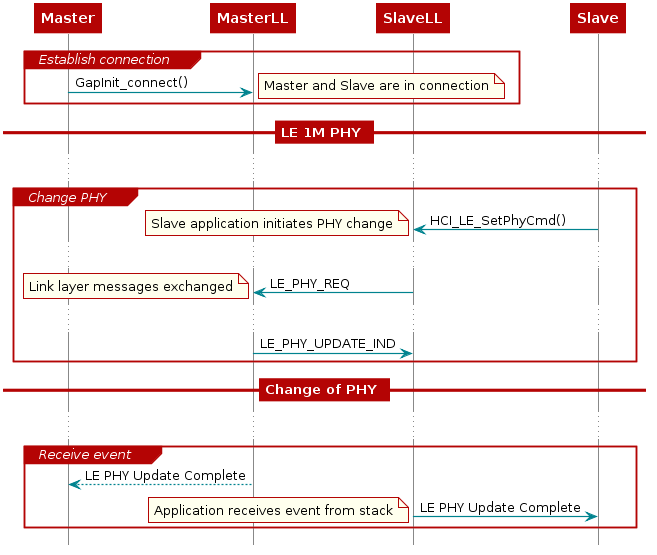LE 2M PHY¶
Introduction¶
The BLE5-Stack supports transferring data over the mandatory symbol rate of 1 megasymbol per second (Msym/s) where 1 symbol represents 1 bit. This results in a bit rate of 1 megabit per second (Mb/s), which is referred to as LE 1M PHY. The stack also supports an optional symbol rate of 2 Msym/s, with bit rate of 2 Mb/s, which is referred to as LE 2M PHY. This LE 2M PHY feature is introduced in the Bluetooth Core Specification Version 5.0 in addition to the LE 1M PHY previously supported.
All the projects in BLE5-Stack have support for LE 2M PHY by default; APIs need to be called in the application to utilize the feature.
- The following HCI commands were added to support this feature:
- LE Set PHY Command (HCI_LE_SetPhyCmd())
- LE Set Default PHY Command (HCI_LE_SetDefaultPhyCmd())
- LE Read PHY Command (HCI_LE_ReadPhyCmd())
When the HCI_LE_SetPhyCmd() is called, the controller starts the PHY Update Procedure to change the PHYs. The procedure consists of exchanging the PHY preferences of both devices and negotiating the correct PHY to use based on the PHY preferences. Depending on peer device capability and preference(s), the PHY Update Procedure may not result in a change to the active PHY configuration.
LE 2M PHY vs LE 1M PHY¶
The LE 2M PHY feature uses the same transmit power as the LE 1M PHY, the only change is in the modulation of data in the PHY. Using the LE 2M PHY, the energy consumption decreases due to higher data modulation at the same output power. The following table lists some of the differences between the two PHYs:
| Parameter | Comparison |
|---|---|
| Power consumption | Energy consumption is reduced using the same transmit power. |
| Data Rate | LE 2M PHY is 2x faster to transmit data than LE 1M PHY. |
| Receive Sensitivity | The link budget will be lower relative to LE 1M PHY, due to the increased symbol rate. |
| Tramsmit Power | The output power is same for both PHYs. |
The main advantage to use the LE 2M PHY is for high throughput applications to transfer data at a higher speed.
PHY Limitations¶
The following are the current PHY limitations in BLE5-Stack:
- The BLE controller does not support autonomous change of PHY during connection where the Link Layer initiates PHY change. Connections are always formed at 1M PHY. It is up to the application or the peer device to call HCI_LE_SetPhyCmd() to change to a different PHY.
- The BLE controller does not support asymmetric connections where the connection uses different PHYs in each direction (RX and TX).
- The PHY_options parameter in HCI_LE_SetPhyCmd() will be supported in future release along with LE Long Range feature.
Default PHY¶
The application can call HCI_LE_SetDefaultPhyCmd() to set the default PHY preferences for both master and slave configurations. If no preference is specified or the API is never called, then the stack will use all supported PHY(1M + 2M). Similarly for HCI_LE_SetPhyCmd(), if no preference is specified, then the stack will use the default PHY (i.e. the connection PHY as defined by HCI_LE_SetDefaultPhyCmd()), otherwise it will use what is specified in the parameters.
The HCI_LE_SetDefaultPhyCmd() should be called before forming the connection while the HCI_LE_SetPhyCmd() can only be called during a connection. Also note that the HCI_LE_SetDefaultPhyCmd() does not change the PHY, only the HCI_LE_SetPhyCmd() can change the PHY. The preferences set by HCI_LE_SetDefaultPhyCmd() are used in these two cases:
- The peer remote device initiates the PHY Update Procedure using HCI_LE_SetPhyCmd() to negotiate the correct PHY to use based on the preferences from both devices.
- The HCI_LE_SetPhyCmd() is called with the AllPhys parameter set to 1(indicating no preference among the supported PHYs)
See an example of this in PHY Negotiation.
Changing PHY¶
The application can initiate a PHY Update Procedure in a connection regardless of the roles of the devices. The PHY preferences that are set by HCI_LE_SetDefaultPhyCmd() are used by default during a set PHY negotiation unless changed by the HCI_LE_SetPhyCmd(). The HCI_LE_SetDefaultPhyCmd() is used to specify the preferred PHY for transmit and receive for all subsequent connections. However, when the HCI_LE_SetPhyCmd() is used to change the PHY for the connection, the change only applies to that connection (subsequent connections will revert to using the default PHYs).
The parameters for both HCI_LE_SetDefaultPhyCmd() and HCI_LE_SetPhyCmd() are same. The ALL_PHYS parameter specifies whether the other two parameters (TX_PHYS and RX_PHYS) are used or not. Master value of ‘1’ indicates the client has no PHY preference for that direction, while a ‘0’ indicates that the corresponding parameter should be used. The TX_PHYS and RX_PHYS can be set to specify which PHY to use for transmitting and receiving, respectively. Note that when all supported PHY are specified, the stack always tries to select the fastest PHY during a set PHY negotiation, see an illustration of this in PHY Negotiation.
The sequence diagram below shows the use case where the master initiates the PHY update procedure:

Figure 48. Sequence diagram for changing PHY by Master¶
Alternatively, the slave can also initiate the PHY Update Procedure as well using the same API as shown below:

Figure 49. Sequence diagram for changing PHY by Slave¶
If the PHY does not change (for example, if Master tries to change to a PHY not supported by the Slave), then only the side that initiated the PHY Update Procedure will get hciEvt_BLEPhyUpdateComplete_t event. The other side will not receive a hciEvt_BLEPhyUpdateComplete_t event if the PHY is not changed represented by the dotted arrow line.
PHY Negotiation¶
Determining when the PHY will change can be determined by looking at the PHY preferences of both devices after the HCI_LE_SetPhyCmd() is called. If both devices prefers to use 2M, the PHY will change to 2M. If the PHY is changed to 2M due to Master preference of only 2M, then the Slave cannot change the PHY back to 1M until the Master changes its PHY preference to support 1M as well. Similarly if the PHY is changed to 1M due to the Slave preference of only 1M, the Master will not be able to change the PHY to 2M until the Slave changes its PHY preference to support 2M as well.
If one device initiates change to a PHY not supported on other remote device, the initiating side will receive a hciEvt_BLEPhyUpdateComplete_t event with nonzero status indicating the change was not successful. If the PHY does not change after HCI_LE_SetPhyCmd() is called, the connection continues with the current PHY.
Use the following API to change/set the PHY:
1 2 3 4 5 6 7 | static uint8_t phy[] = {
HCI_PHY_1_MBPS, HCI_PHY_2_MBPS, HCI_PHY_1_MBPS | HCI_PHY_2_MBPS,
};
// Set Phy Preference on the current connection. Apply the same value
// for RX and TX.
HCI_LE_SetPhyCmd(connectionHandle, 0, phy[index], phy[index], 0);
|
The user selects the preference of the PHY to use by selecting an index of the phy[] array. For example, if the user prefers to use 2M PHY, the user would pass in HCI_PHY_2_MBPS for the TX and RX PHY preferences for the HCI_LE_SetPhyCmd(). Then based on the PHY negotatiation, the PHY will change if the peer remote device supports it, otherwise, it will continue using the current PHY. This is one way to change the API, see simple_peripheral project for the complete example. After this command is sent, the controller will send a hciEvt_BLEPhyUpdateComplete_t which will indicate completion of this command:
1 2 3 4 5 6 7 8 9 10 11 12 13 14 15 16 17 | static uint8_t SimplePeripheral_processStackMsg(ICall_Hdr *pMsg)
{
...
case HCI_LE_EVENT_CODE:
{
hciEvt_BLEPhyUpdateComplete_t *pPUC = (hciEvt_BLEPhyUpdateComplete_t*) pMsg;
if (pPUC->BLEEventCode == HCI_BLE_PHY_UPDATE_COMPLETE_EVENT)
{
if (pPUC->status != SUCCESS)
{
Display_print0(dispHandle, SBP_ROW_STATUS_1, 0, "PHY Change failure");
}
else
{
Display_print0(dispHandle, SBP_ROW_STATUS_1, 0,"PHY Update Complete");
...
|
See Host Controller Interface (HCI) for more information on receiving HCI events.
Note
For more information on the LE 2M PHY, see See [Vol 6] Part Master, Section 4.6.9, Multiple PHYs, of the BLE 5 Specification
